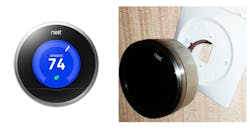Use a Common Wire With a Nest Thermostat (or Suffer the Consequences)
It was one of those weekends. Being rather cold out, the air conditioner (of course) decided it was going to start running. When the usual check of my Nest thermostat didn’t provide any insight, I flipped the breaker to turn it off. Since this looked to be an AC problem, I decided to call for help. Luckily the heat side of the system was still working…for now.
The repairman arrived the next day and determined the problem was the Nest’s wiring, as pulling the AC wire turned off the AC. That indicated a problem with the Nest or its base. The repairman then left, since the wiring and thermostat were my problem (Fig. 1) .
I had another Gen 1 Nest, but it turned out that that one didn’t want to work either, so I did a little digging. I made liberal use of my digital multimeter (DMM), as well as online searches to trace the problem to the fact that I used five wires without a common (C) wire. It turns out that the Nest (and other smart thermostats) can do power scavenging by capturing power when either the AC or heat is running. It can also turn the heat or AC on and off quickly so the systems do not appear to run.
I probably should have run a new cable with an extra wire in it, but the system had been working for a number of years. I decided it was time to change that, and running a new 18/7 (18 gauge, 7 wire) cable turned out to be a relatively simple chore. Of course this meant doing more work on the Nest base to disconnect the old cable and attach the new one.
Here I ran into another issue. I have a system with two transformers, one of AC and the other for heat. I had temporarily used one of the AC wires as the common when just using the heat subsystem. That appeared to work okay, but adding the AC into the mix with the new cabling caused an issue: If the Rc line is added to the mix, then the Nest assumes that the common line is from the other side of the AC transformer.
Swapping wires in and out of the Nest base seemed to mess up the base, as the detection of the Rc and Rh was transient at best. In any case, the Nest was essentially unusable and would not even work with the heat-only system for one of my other thermostat connections.
It got worse, though. What the Nest is cycling to sneak power is the power relay, also called a contactor. The hope is that the process does not start the AC compressor. Unfortunately, this can be detrimental to the hardware, and it appeared to be a problem here as well since the AC decided to go on again—this time with the thermostat line disconnected—and stay on. A new contactor was required.
I wound up switching to Honeywell’s RTH9580 Wi-Fi thermostat (Fig. 2) instead of going with another Nest. In theory the new cable with a common wire would solve any problems, and the system might have worked with just five wires, but I would not recommend it.
The RTH9580 installed easily, and linking it to my Wi-Fi network was easier with the touchpad compared to the Nest’s rotating case. The Honeywell unit was a little less expensive than a new Nest and is functionally equivalent. It does have a motion sensor like the Nest, but I never took advantage of it with the Nest because the placement of the thermostat is where there is little traffic to trigger it.
Unfortunately, both the Honeywell or Nest thermostats require a connection to the internet to use the matching smartphone app. I would rather have something that worked within the LAN since I can use my VPN to get access to it. There is a business mode, in addition to the home mode I used, that could benefit from LAN-based management software, but that isn’t how things operate at this point.
My Honeywell thermostat is on its own VLAN that is only connected to the internet. Let me know if anyone figures out how to hack the RTH9850. It would be a nice platform for some open-source software, but that is unlikely to happen.
A couple things I didn’t like about the RTH9850 include the default display and its mounting. Luckily, the display can be configured; I really did not like white text on a background that included white sections. The mounting is only an issue if you need to change things, and that is unlikely since the unit should stay in place until it breaks. I did like the Nest, which can be easily removed. Of course, I never took advantage of that until I wound up replacing it.
I do wish that the documentation or online information about the Nest included more details on how its power sipping system worked and how it uses the common line. Using a two transformer system is not unique, but nor is it likely common. Consequently, some of the issues I ran into may not be common, either.
I could have gotten away with a unit that did not have Wi-Fi capability, but it is much easier to program the system with an app on a PC or tablet than with the small screen on the unit. If you do decide to go with a smart thermostat that does not have on-board batteries, make sure you have a C wire.
By the way, the heat-only thermostat is now the original mechanical thermostat that I kept. It still works and does not require Wi-Fi.



